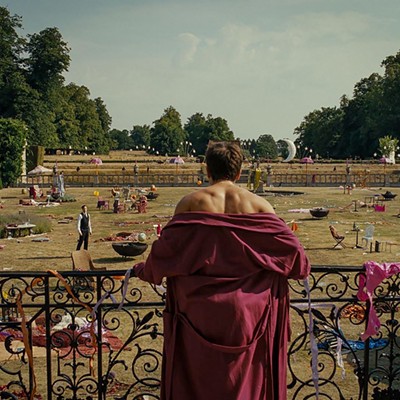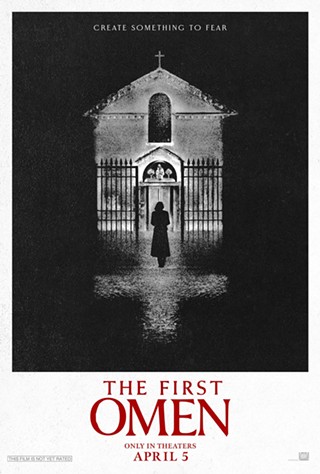He has also said the six-hour film cycle is about the descent of his testicles, symbolizing the moment at which sexual differentiation occurs. Actually, if you just listen to what Matthew Barney says, you'd think he was a total idiot who made a really long movie about his balls.
The films, on the other hand, are some of the most beautiful and captivating ever made. While largely non-narrative, they create a kind of narrative cohesion through the repetition of simple images in myriad forms and environments. The frequent but well-paced re-appearance of spheres, bisected ovoids, and hexagons become exciting plot points by virtue of the seemingly limitless visual imagination in the films.
How Barney could be so visually talented and verbally retarded could be the subject of a lengthy tome, but it really doesn't matter. The films replace spoken language with a vocabulary of forms which, if you give them a chance, tell a story that is almost totally alien to our standard sense of narrative, yet completely comprehensible on a purely visual plane.
The five Cremaster films (the "cremaster" is the muscle which attaches to the testicles and allows them to move up and down) are probably best seen together, and you'll have a chance to see them in that manner this weekend at the Loft, or you can catch them individually over the course of the week. Whichever way is best for you, though, you really owe it to yourself to see these films. Their status in the arts community is huge enough to have created a tidal wave of backlash, which means there must be something worthwhile going on here. Having a chance to see these films now is not unlike being at the 1937 World's Fair for the unveiling of Guernica.
Of the five films, the fourth is probably the most tightly realized and accessible to general audiences. Filmed on the Isle of Man, it features Barney as "The Loughton Candidate." Dressed in a white suit, and with a head that is half human and half goat, he tap-dances on a wax floor until he falls through and into the ocean. Then he begins a monumental climb through a convoluted tunnel that is coated in Vaseline. Palpably frightening and tense, the climb gives the film a strong trajectory as Barney tries to escape from the claustrophobic and greasy underworld.
At only 42 minutes, Cremaster 4 is also one of the shortest films of the cycle. The longest is Cremaster 3, which, while no doubt the masterpiece of the series, probably could have used some trimming. Ostensibly the story of an apprentice Freemason working his way into the inner circles of the organization, it's more a visual summation of the entire series. Incredibly gorgeous scenes on the Isle of Man, wherein two giants fight while babbling in an unknown language, lead into a scene in the lobby of the Chrysler building.
There, after a corpse crawls out of muck and makes its way into the back of a Chrysler Imperial New Yorker, five 1967 Chrysler Crown Imperials engage in a brutal demolition derby until only a compacted cube of metal remains. Meanwhile, Barney, dressed nattily, fills the elevator with cement. This turns out to be a bad idea, as a field of decomposing horses races by while evil Freemasons knock out Barney's teeth and then force them down his throat and out the other end of his digestive track.
After that, things get a little bizarre, as a battle of the bands ensues inside the spiral rotunda of the Guggenheim Museum. While '80s punk favorites Agnostic Front and Murphy's Law fight it out with guitar and bass, '80s art favorite Richard Serra tosses hot Vaseline about and Barney tries to climb the rotunda. Then some really weird shit happens.
While Cremaster 3 is meant to be the capstone of the series, Cremaster 2 is nearly as visually elaborate, and hews more closely to our standard sense of what a movie is. A gruelingly long opening sequence features Barney, playing Gary Gilmore, climbing along an organic bridge between two 1967 Ford Mustangs. While this section doesn't exactly work, what comes after is amazing. Gilmore, strapped to the electric chair, receives a phone call from Johnny Cash, who is played by former Slayer drummer David Lombardo, Morbid Angel vocalist Steve Tucker and actor Bruce Steel. Yes, it takes three people to play Johnny Cash, and there are bees crawling on them while they do it. I'm sure that's how Johnny would have wanted it.
Cremaster 2 culminates in what is probably the series' most visually appealing sequence, a rodeo-to-the-death staged on a giant arena made out of salt. As in most films about convicted killers, the Mormon tabernacle, Harry Houdini and the Canadian Mounties all make appearances.
Cremaster 1 takes place on a blimp and a football field, and while some people consider this the best of the films, I thought it lacked the precision of the other installments. Cremaster 5 is a sort of opera starring Ursula Andress, and, while occasionally too slow for its own good, it does have an amazing sequence of Japanese water nymphs frolicking in a lily-pad pond that teems with testicular orbs.
These orbs are probably the main characters of the entire cycle. Still, they share the stage with Jonathon Bepler's cool and apt musical score, and some of the most inventive title and credit lettering in cinema history. Every aspect of these films is presented as a cohesive element of the whole, producing a sense of overall vision. While these are obviously not "movies" in the common sense, they are some of the strongest and most innovative examples of film as art that have ever been attempted, taking the creative force of the German expressionists and American experimentalists to a new level by virtue of the cost and scope of the production. Not to be missed by the art connoisseur or anyone who wants to see a woman with plastic legs slice potatoes with her shoes.











